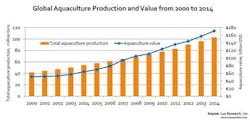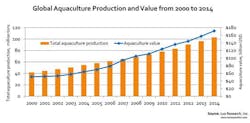BOSTON, MA, March 10, 2015 -- According to new findings from Lux Research (LR), an independent research and advisory firm, water treatment is essential to successful aquaculture, and demand for water treatment is expected to nearly double from $7.2 billion in 2014 to $13.3 billion by 2030.
Aquaculture -- the farming of fish and other aquatic animals -- is an increasingly vital means of supplying demand for seafood, as wild fisheries suffer from stress and collapse.
"Aquaculture is leading to a 'Blue Revolution' as the world shifts from hunting and gathering aquatic resources to farming them," said Abhirabh Basu, LR associate and the lead author of the report, titled "Blue Revolution: The Fast-growing $7.2 Billion Water Treatment Opportunity in Aquaculture."
"However, without water treatment, fish populations swim in a putrid cocktail of dead fish, feed, feces, and nutrients that breeds disease and endangers entire crops -- advanced treatment systems are essential for the market to grow," he added.
LR researchers evaluated opportunities in the rapidly growing market for advanced water treatment in aquaculture. The following lists some of their findings:
- Recirculating aquaculture systems (RAS) enjoy many advantages. Currently, advanced reuse systems represent only 4.5 percent of the total aquaculture market, with pond culture being the dominant means of production. However, by 2030, RAS will produce over 40 percent of the total aquaculture output.
- Europe is poised to be a leader in water reuse systems. Between 2000 and 2013, the U.K. added 25 RAS facilities; Norway's Nofima, the largest aquaculture research facility in Europe, has installed over 1,000 tanks and hatcheries; and Denmark expects 90 percent of its aquaculture production to stem from recirculating systems.
- Wastewater companies are leveraging expertise to tap the RAS market. Kruger Kaldnes, a Veolia subsidiary, has tapped its traditional moving bed biofilm reactor for aquaculture. Among promising startups, BioGill uses vertical membrane sheets, and BioFishency has built an "all-in-one" plug-and-play solution.
See also:
"Secondary wastewater treatment improved with passive aeration, process control, report finds"
"Recovering oil and precious metals from wastewater creates new revenue streams"
About Lux Research
Lux Research provides strategic advice and ongoing intelligence for emerging technologies. Leaders in business, finance and government rely on us to help them make informed strategic decisions. Through our unique research approach focused on primary research and our extensive global network, we deliver insight, connections and competitive advantage to our clients. For more information, visit www.luxresearchinc.com.
###




